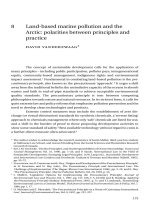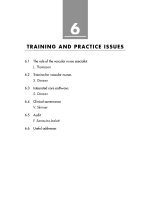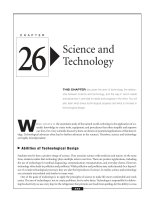Track-1-Restoration-Science-and-Practice
Bạn đang xem bản rút gọn của tài liệu. Xem và tải ngay bản đầy đủ của tài liệu tại đây (89.13 KB, 2 trang )
2016 Chesapeake Watershed Forum/TRACK 1: Restoration Science & Practice
A: Friday, Sept. 30, 1:30 – 3:00
Watershed Restoration Project Management Training – In a Nutshell
Moderator: Sadie Drescher, Chesapeake Bay Trust
Watershed groups manage grant projects that are large (>$100,000) and complicated. The Chesapeake Bay Trust as part
of the Capacity Building Initiative saw watershed groups that struggled to manage and implement these larger
restoration projects and identified this as a training need. The Watershed Restoration Project Management Training was
offered as a four-day session and a mentoring opportunity led by Johnson, Mirmiran and Thompson’s (JMT) in 20152016.
This Watershed Forum session will provide an abbreviated Watershed Restoration Project Management Training session
with the JMT training lead, Jeremy Koser, offering the top tips for project management, organizational readiness,
planning, design management, construction, and maintenance for your project. Attend this session to learn how to
manage your restoration project team to meet grant program objectives and implement successful projects.
Presenter:
Jeremy Koser, PE, Johnson, Mirmiran and Thompson’s (JMT), Water Resources Practice Leader
B: Friday, Sept. 30, 3:30 – 5:00 pm
Monitoring and Assessment: New Tools and Proven Approaches for Measuring and Moving Towards
Success in Restoration
Moderator: Jake Reilly, National Fish and Wildlife Foundation
With the roll-out of a cradle-to-post implementation tool for tracking and assessing BMP progress, NFWF, the MD
Department of Natural Resources, and other funders have made it possible to more easily calculate the nutrient and
sediment reductions possible and in practice from pollution reduction practice installation. Chesapeake Commons, the
developer of the tool, “FieldDoc”, have provided partners with a BMP calculator is user-friendly and enables a
streamlined approach to determining the pollution reductions possible for stormwater, agriculture, and stream
restoration projects and in synch with the Chesapeake Bay Program Watershed model. Other proven approaches to
monitoring and assessing progress towards restoration have been deployed across the Bay watershed as well, including
“visual indicators” checklists for resource improvements that provide practitioners with guidance for evaluating the
performance of physical structures and management techniques. Join this discussion to see the new and proven tools of
the trade and how best to integrate them into your practice monitoring efforts.
Presenters:
R. John Dawes, Executive Director, Chesapeake Commons; Bob Ensor, Howard County Conservation
District; Dana York, Green Earth Connection; Rich Starr, Ecosystem Planning and Restoration
C: Saturday, October 1, 10:00 – 10:50 (50 min.)
Protecting the Stream – High Impact and Cost Efficient
Moderator: Sadie Drescher, Chesapeake Bay Trust
We are all working together to prevent pollution from entering our streams. Attend this session to hear Trash Free
Maryland’s Julie Lawson share the latest results about microplastics, including what they are, the problem they pose for
our streams, and how to prevent further degradation of the waterways. Also, attend this session to hear from Penn
State’s Kristen Kyler about live staking, reintroducing plant life directly into the stream banks as a low, cost and high
return stream improvement practice to increase bank stability and decrease erosion. These sessions will take us from
the urban landscape to the agricultural fields and the streams that are drain them both.
Presenters:
Julie Lawson, Trash Free Maryland; Kristen Kyler, Pennsylvania State University’s Greening the Lower
Susquehanna Project
TRACK 1: Restoration Science & Practice (Cont.)
D: Saturday, October 1, 11:10 – 12:00 (50 min)
Soil Health (for Water Quality) in Agriculture and Urban Landscapes
Moderator: Ron Ohrel, Mid-Atlantic Dairy Association
Clean and abundant water starts with soil health and function. Healthy soils assure plant productivity, improve
infiltration, retain water, utilize nutrients, filter stormwater, and resist erosion. It’s no surprise, then, that the
connections between healthy soils and water quality are growing topics of interest. This session will feature
presentations addressing the connections between healthy soils and water quality in both agricultural and urban
landscapes.
Presenters:
Jim Harbach, Schrack Farms, Pennsylvania; Stuart Schwartz, Center for Urban Environmental Research
and Education, University of Maryland Baltimore County
E: Saturday, October 1, 1:30 – 3:00
Innovative Practices – A Deeper Dive into Resource Recovery
Moderator: Ron Ohrel, Mid-Atlantic Dairy Association
Nutrients such as nitrogen and phosphorus are essential to crop production, but they can cause water quality problems
when they enter the Chesapeake Bay and its tributaries. The capture and recovery of valuable nutrients before they
enter local waterways not only has implications for improving water quality, but also holds great economic potential.
This session will discuss some emerging technologies for treating wastewater and livestock manure in ways that reduce
nutrient loads to the environment and create marketable products.
Presenters:
Steve Rowe, Newtrient LLC; Philip L. Sibrell, U.S. Geological Survey
F: Saturday, October 1, 3:30 – 5:00
Siting, Design and More – Considerations for Restoration in a Watershed Context
Moderator: Kristen Saacke Blunk, Headwaters LLC
Improving water quality requires that the right practice (or suite of best management practices) are selected for the
right location to ensure the greatest environmental response in respect to reducing the potential of pollutants to reach
or impact natural waters. Making the field based determination of which practice and where is informed by teams with
expertise across the areas of ecology, hydrology, land management, and engineering. The National Conservation
Training Center has served as a model for conservation practice implementation and provides an excellent field
opportunity to observe past and current BMP implementation efforts.
This session will enable participants to get out on the ground to explore stormwater management systems and
measures that NCTC has implemented and to learn more about the opportunities and challenges associated with the
siting, design, and on-going placement and prioritization of these BMPs.
Presenter:
Casey Johnson, US Fish and Wildlife Service, NCTC’s Land Management Office









